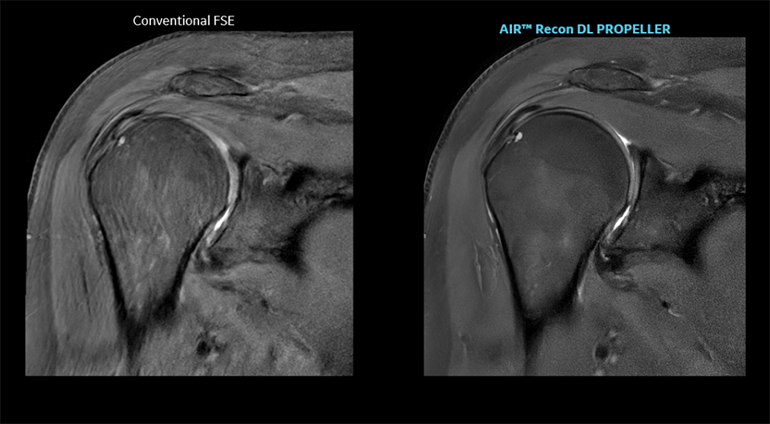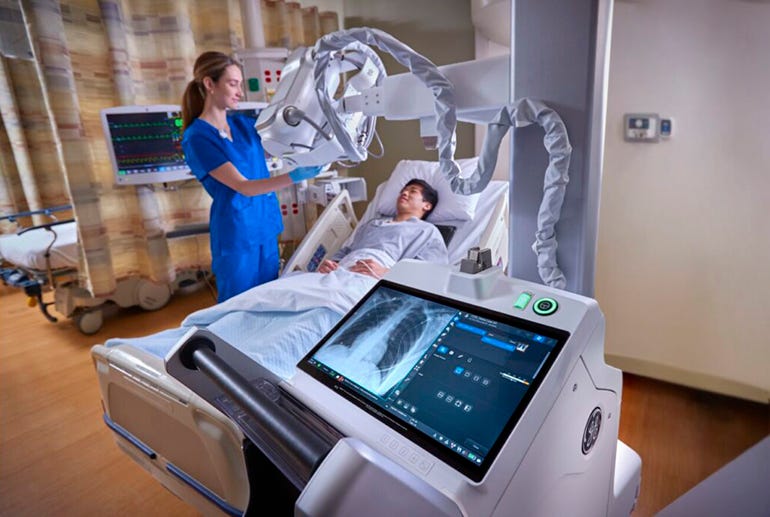The Health Strategist
research and strategy institute
for continuous transformation, of
in person health and digital health
Joaquim Cardoso MSc
Chief Research and Strategy Officer (CRSO)
9 de maio de 2023
ONE PAGE SUMMARY
This executive summary provides an overview of the role of artificial intelligence (AI) in healthcare, particularly in medical imaging, based on an exclusive interview with Catherine Estrampes, President & CEO at GE Healthcare.
- The use of AI in healthcare is rapidly increasing, offering opportunities to reduce clinician workloads, improve patient outcomes, and revolutionize medical imaging.
The integration of AI in healthcare aims to automate administrative tasks, such as appointment scheduling and medical record updates, allowing clinicians to focus more on direct patient care and potentially reducing clinician burnout.
- AI-powered tools can also monitor patient health in real-time, aiding clinicians in detecting changes in a patient’s condition earlier and enabling quicker interventions.
In the field of medical imaging, AI is already being utilized to automate image analysis, leading to faster and more accurate diagnoses.
- It can identify anomalies and abnormalities in scans, improving the accuracy of diagnostic tests and reducing the need for invasive procedures.
- Additionally, AI is driving the development of new imaging technologies that enhance diagnostic accuracy and speed.
Despite these advancements, challenges exist in the implementation of AI in medical imaging.
- Biases in AI algorithms due to training data can lead to inaccurate results, and the lack of explainability of AI algorithms can cause mistrust in the technology.
- Furthermore, AI algorithms rely on large amounts of data, which may not always be readily available.
However, it is emphasized that the jobs of radiologists and pathologists are not at risk, as AI is not yet capable of surpassing human expertise in certain areas.
GE Healthcare acknowledges the challenges faced in medical imaging, particularly in relation to clinician burnout and increasing workloads.
- AI can assist clinicians in managing new data types and volumes generated by evolving technologies.
- The use of AI algorithms in imaging technologies improves image quality, reduces diagnosis times, and helps radiologists become chief diagnosticians.
GE Healthcare emphasizes the adaptability of its hardware to accommodate future AI software upgrades.
- Upgradable CT systems and regular software updates enable healthcare providers to integrate the latest applications and software seamlessly into their existing equipment.
- The Edison Digital Health Platform is being developed to facilitate the rapid deployment of clinical, workflow, and analytical tools for improved care delivery.
The future of imaging lies in the continued integration of AI, which will enhance productivity and reduce wait times for diagnosis and treatment.
- GE Healthcare’s Critical Care Suite 2.0, an AI solution embedded in a mobile x-ray system, has significantly reduced turn-around times for radiologists in detecting pneumothoraxes.
- Growth is also anticipated in telehealth applications for imaging procedures, facilitating remote collaboration and second opinions.
AI-powered solutions have the potential to alleviate pressure on clinicians and meet customer and patient needs.
- AI can revolutionize administrative processes, reducing physician burnout.
- Command centers equipped with AI technology, such as GE Healthcare’s, enable real-time data monitoring, identification of bottlenecks, and efficient resource allocation, leading to significant time and cost savings.
In addition to improving imaging and operational efficiencies, AI is expected to drive precision care by leveraging unique patient data to determine personalized treatment plans.
- Precision diagnostics, treatment, and monitoring will be crucial in delivering the best possible outcomes for patients.
Overall, AI has the potential to transform healthcare, particularly in medical imaging, by improving efficiency, accuracy, and patient outcomes.
- GE Healthcare is committed to developing innovative solutions and hardware that integrate AI technologies to meet the evolving needs of healthcare providers and deliver high-quality care.
DEEP DIVE

AI’s role in Healthcare: Exclusive Interview with Catherine Estrampes, President & CEO at GE Healthcare
MedGadget
ALICE FERNG
MAY 3RD, 2023
AI is increasingly being used in healthcare to reduce clinician workloads and improve patient outcomes. AI-driven technologies are helping to automate mundane tasks, freeing up clinicians to focus on more complex clinical decisions. Importantly, this may also help reduce clinician burnout. AI-powered tools can also help identify patterns in medical data that can lead to faster diagnoses and better patient outcomes.
From the perspective of low hanging fruit, AI can be used to automate tedious administrative tasks such as scheduling appointments, updating medical records, or processing paperwork, saving clinicians time allow them to devote more of their efforts to direct patient care. Another emergent trend is using AI to monitor patient health — providing valuable real-time feedback on their status. In a world of wearables, this can help clinicians spot changes in a patient’s condition earlier than would otherwise be possible, leading to quicker interventions that could potentially save lives.
However, AI can also be powerful during the diagnostic process in multiple ways, from providing insights that could help reduce mortality rates and lead to earlier detection and treatment options, to helping solve practical bandwidth limitations of clinicians during their workdays. The goal, of course, is to provide clinicians with faster results, automate the analyses of patient data, and help them make better informed decisions about a patient’s care.
AI is already playing a major role in medical imaging by helping to automate image analysis and reduce the amount of time needed to interpret scans. Anomalies and abnormalities can be quickly detected with AI-based algorithms, such as tumors, and provide clinicians with more accurate diagnoses. The accuracy of diagnostic tests can also be improved with AI, which reduces the need for costly and invasive procedures. Additionally, AI is being used to develop new medical imaging technologies that will improve the accuracy and speed of diagnoses. Algorithms can be used to detect changes in medical images that may be too subtle or difficult for humans to detect.
However, AI in medical imaging also comes with a few potential pitfalls. For example, AI algorithms can be biased due to the data they are trained on, which can lead to inaccurate results. Additionally, these algorithms are not always able to explain why they reached a certain conclusion, which can lead to confusion and mistrust of the technology. Other times, present AI may simply fall short of a human’s ability to identify a net new diagnosis that is not based on existing documented knowledge, or is currently classified as “idiopathic.” Finally, AI algorithms require large amounts of data to be accurate and reliable, which can be difficult to obtain in some cases.
For these reasons, and many more, rest assured that the jobs of radiologists or pathologists are not at risk. Gary Marcus’s article on how “Deep Learning Is Hitting A Wall” highlights why.
Despite these potential issues and challenges, the use of AI in medical imaging is rapidly growing and is expected to become increasingly prevalent in the coming years, as it is also expected to further reduce the cost of medical imaging. Ultimately, AI has the potential to revolutionize medical imaging and improve healthcare outcomes around the world. To hear more about these topics, we had a chance to interview Catherine Estrampes, President and CEO, US & Canada at GE Healthcare.
Alice Ferng, Medgadget: Thank you for taking the time to talk to us! Tell us about yourself — your background and how you got to where you are today at GE Healthcare.

Catherine Estrampes, President and CEO, US & Canada at GE Healthcare: I began my career at GE HealthCare Europe in 1990 where I held various business leadership roles in Cardiology, Interventional, and CT product lines and gained extensive international exposure. In 1999, I joined GE Capital in the U.S. and held several General Manager roles both for GE Capital Equipment Finance and GE HealthCare Financial Services Global Vendor division. In 2010, I served as General Manager for the $1.4B Mid-America business unit in GE HealthCare U.S. and Canada, and in 2013 my responsibilities expanded to lead the Central Corridor $2.5B business unit. Four years later I joined GE HealthCare Europe to lead the Imaging business unit before being appointed President & CEO of GE HealthCare Europe/Russia, which was later expanded to include Europe, the Middle East, and Africa (EMEA).
As of 2021, I lead our U.S. and Canada region of 8,000 team members and $8B business unit of GE HealthCare that provides healthcare technologies, services, and solutions to help providers improve healthcare quality, access, and affordability across the region.
Medgadget: What are the main challenges you face today in medical/clinical imaging? What challenges do you see ahead? Are we prepared to meet those challenges?
Ms. Estrampes: The COVID-19 pandemic led to an influx of patients, both for treatment of the virus and for those whose conditions stem from delayed regular doctor visits and exams due to the pandemic. This has exacerbated clinician burnout and, subsequently, increased the staffing shortages already facing healthcare providers. As a result, we are seeing providers prioritize finding ways to alleviate clinician burnout and become more efficient with their existing resources and staff. This strategy shift trickles down to imaging departments, where radiologists are experiencing exceptionally high increases in workload leading many to report burning out.
For clinicians, including radiologists, the continual adoption of new technology is generally seen as a positive. The opportunity exists to help clinicians manage the new types of data being generated from new technology and the increased volume of data available to them. It is estimated as much as 97 percent of all healthcare data each year goes unused, resulting in the loss of valuable insights 1. AI is changing this.
Crucially, AI is assisting technicians and radiologists alike with the adoption of new imaging technologies, promising to reduce the burden of learning new technologies as systems continue to modernize. Theranostics treatments are increasing, for example, with new developments of the therapy option being used to treat a variety of cancers such as prostate, endocrine, and thyroid cancer. We expect the demand for radiology solutions to rise, and AI will play a big role in that.
Medgadget: What do you see ahead in terms of how AI will revolutionize advances in imaging?
Ms. Estrampes: The most significant change I expect to see is a shift in the role of radiologists toward becoming a chief diagnostician. This largely has to do with AI’s use in imaging — one of the core markers of precision care — which will help improve image quality and reduce diagnosis times.
A technology transforming this space is our AIRTMRecon DL reconstruction algorithm available on many of our MRI systems, which produces sharper images by leveraging all the raw MRI acquisition data, allowing for improved image quality. From there, it’s at the clinician’s discretion to order more tests and collect more data based on what they see. Incorporating these technologies creates a better patient experience because it leads to shorter exam times with staff number staying the same.

Capabilities will continue to grow beyond traditional imaging applications. TrueFidelity, for example, leverages first of its kind deep learning image reconstruction (DLIR) to utilize a deep neural network-based recon engine to generate high quality CT images. DLIR opens a new era for CT-image reconstruction by addressing challenges of filtered back-projection and iterative reconstruction. The result: unprecedented clarity, thanks to maintained contrast visualization and edges, and minimized noise and artifacts. We should anticipate seeing more devices capitalize on AI’s possibilities, including Machine and Deep Learning.
Our priorities align with those of our customers, who are looking to use AI, DL, and ML to increase workflow efficiencies and see more patients. So, what you have are clinicians with a holistic view of the patient in a better position to inform the kind of precise care needed, thanks to the efficiencies brought on by AI.
Medgadget: Will the existing hardware be sufficient for future AI software upgrades? I’m anticipating there to be a hardware gap as we make more scientific discoveries and predictions that help us leap forward in our understanding of quantum theories. It seems quite probable we’ll need to innovate our hardware to be able to detect even more and to be able to collect/store larger amounts of data, as well as process even larger amounts of data. What does GE HealthCare have planned in this realm?
Ms. Estrampes: New scientific discoveries are made all the time and hardware must be able to adapt. GE HealthCare continues to introduce new CT products, and we believe that part of how we create value is in the upgradeability of our equipment. For example, our Revolution Apex Platform, a GE HealthCare designed CT scanner, was built to be ‘future proof.’ Its modular design allows for most onsite upgrades without replacing the gantry and with the possibility to upgrade its rotation time. Moreover, the Revolution platform software offers regular software updates with new capabilities and the ability to access GE HealthCare’s latest clinical applications. As a result, radiology departments can seamlessly upgrade their equipment on a regular basis instead of purchasing a new machine each time a new feature is introduced.
AI and other software are just as important in the upkeep of hardware. Software that pulls data directly from the machine, allowing providers to get access to rich data from their devices, can lead to great cost savings. Imaging Insights, a GE HealthCare solution, sifts through real-time data from multiple sources to keep medical imaging departments well informed on the status of their machines, allowing them to focus on optimizing operational efficiencies, workflow improvement, clinical excellence, and financial growth. The proof is in the numbers. One of our clients, Radiomed, saw a 36.5 percent increase in the number of weekly exams thanks to Imaging Insights’ ability to regularly update and correlate multiple data sources into one consolidated view 2. ( As each hospital is unique, results may vary. GE HealthCare does not guarantee the results identified herein.)

Looking to the future, GE HealthCare is committed to providing clinicians access to the latest applications and software as seamlessly as possible, which means ensuring that they can be integrated into current hardware.
For example, our Edison Digital Health Platform is being developed to help hospitals and healthcare systems rapidly and securely deploy the clinical, workflow, and analytical tools required for improved care delivery, high-efficiency operations, and increased revenue growth.

Medgadget: What’s the future of imaging looks like? How do you plan to iterate on existing X-ray, CT, MRI, and other types of imaging technology to provide novel imaging solutions and experiences?
Ms. Estrampes: AI and imaging technologies will continue to help reduce wait times from scan to diagnosis to treatment and drive higher levels of productivity.
This will benefit our customers by allowing them to see more patients, thereby reducing backlogs and with the potential to increasing revenue. ( GE HealthCare does not warrant or guarantee profitability. Ability to achieve profitability is dependent on factors specific to each customer.)
During the pandemic, GE HealthCare introduced Critical Care Suite 2.0, a first-of-its-kind AI solution embedded within a mobile x-ray system that can help clinicians prioritize images that are suspected to contain a pneumothorax (collapsed lung), provide automatic measurements to assist with endotracheal (ET) tube positioning, and more.
When used to support ET tube positioning, the device provides accurate and automated measurements of the tube position. Critical Care Suite does this by using its algorithm to automatically detect the presence of a suspected pneumothorax and ET tube in AP chest X-ray images.
For suspected pneumothoraxes, the device’s mobility allows the application to be brought directly to the patient’s bed where it can scan the patient for a suspected pneumothorax.
If a collapsed lung is detected, the scan is sent to the patient’s doctors, where it is moved up the queue of potentially less serious cases to accelerate patient care, as needed. Since its adoption, it has drastically helped reduce the turn-around time for radiologists to review a suspected pneumothorax. A review at University Hospital Cleveland showed a 78 percent decrease in time to report urgent exams while using Critical Care Suite. Exams went from 3 hours and 22 minutes down to 44 minutes. 3As our technology advances, I only expect the time to decrease further.
I also anticipate seeing growth in telehealth. While telehealth is traditionally associated with outpatient use, its application with healthcare professionals within hospitals for imaging procedures will likely see significant growth. Ultrasound, a very personnel-dependent field of medicine, is an area where this growth will likely take place. An example of such a solution is our Digital Expert platform, which allows for real-time, peer-to-peer collaboration where an ‘expert’ can remotely guide a technician through an ultrasound procedure using a tablet. Should there be anomalies, or the on-the-ground tech needs a second opinion, they can easily do so with colleagues hundreds or thousands of miles away.

Medgadget: How will AI-powered solutions help hospitals alleviate the pressure on clinicians and meet customer/patient needs today and in the future?
Ms. Estrampes: AI has the power to revolutionize healthcare providers’ administrative processes. Administrative responsibilities are a huge contributor to physician burnout.
In 2021, 58 percent of physicians reported “administrative tasks” as the key contributor to their burnout. 4
We are slowly seeing health systems adopt ‘command centers,’ where a central facility monitors and allocates resources within a system with AI technology. GE HealthCare has a proven track record in this space.
Our partners at Tampa General Hospital (TGH) use Command Center ‘Tiles’ to comb through real-time data and identify bottlenecks, risks and barriers related to resources, patients, and personnel.
The Command Center will then use those insights to flag possible actions that hospital staff can take to prevent delays in the patient journey. At TGH, clinicians are saving upwards of 82,000 hours a year, due in large part to the elimination of timely huddles to determine which patients can be downgraded in care, and interdisciplinary team rounds. 5
Another health system, AdventHealth, uses Command Center’s software at one of its facilities, creating the equivalent of 34 additional beds at one facility, increasing its transfer acceptance rate by 800 patients a month. 6This was done by allowing managers to balance utilization across sites by seeing where and when beds and equipment were available in real time and cutting down on time-consuming coordination work. The technology is not limited to one health system.
The Oregon Capacity System uses GE HealthCare’s Command Center technology for a statewide capacity and critical resource management system to allocate life-saving resources in real time.
I expect investments in the development of similar technologies to grow with the increasing provider interest in improving operational efficiencies and improving the patient experience.

Medgadget: What are other areas within health where you think AI will revolutionize medicine and health?
Ms. Estrampes: Outside of improving imaging and operational efficiencies, AI is already playing an important role in driving precision care. It is GE HealthCare’s view that over the next 5 to 10 years providers will focus on enabling personalized care with the right ecosystem. Precision care leverages a patient’s unique data via multi-modal sources to determine the most appropriate course of treatment for the patient to deliver the best possible outcome. This is enabled by precision diagnostics, treatment, and monitoring. Systemwide device connectivity and the ability to process the huge quantities of data they produce will be more crucial than ever.
GE HealthCare’s focus is on effective and efficient personalized care solutions, centered around the digitization of healthcare and applied throughout the patient journey to improve patient health and system-wide outcomes, and increase clinical productivity.
That’s why we work closely with providers to achieve a digital transformation that prioritizes workforce stability, productivity, outcomes, and wellbeing. We are developing solutions that help save valuable caregiver time, resulting in benefits for patients, providers, and the hospital system.
GE HealthCare’s digital technologies can help synthesize the data to make it more meaningful for clinicians so they can spend less time in front of a computer and more time with their patients.
The key advantage we have is being uniquely positioned as an ‘insider’ in healthcare. Many of our devices and solutions span the entire care pathway from diagnosis to treatment to maintenance. Most have digital capabilities that enable devices to communicate with the administrative solutions helping run departments, thus allowing for seamless integration.

The hospital of the future would ideally combine the mixed uses of AI we’ve discussed:
- in imaging, when the patient walks through the door and needs to get diagnosed in a hurry;
- n Command Centers, where staff can triage and efficiently monitor patients; and in platforms, like Edison Digital Health Platform which is under development, which enable providers to manage the workflow and upkeep of a digital health system.
Medgadget: Anything else you’d like to discuss or share with our readership?
Ms. Estrampes: The adoption of digital technologies and AI can lead to better patient outcomes through more accelerated and accurate care in addition to improved operational efficiencies.
GE HealthCare is focused on improving lives through enabling precision care, which can be achieved by putting the patient at the center of the technology and bringing the right data together to help target diagnosis and develop a unique treatment plan.
By connecting data from multiple sources, this can help clinicians diagnose a disease faster and even predict how a patient will respond to a particular treatment.

References
[1] Elevating Digital Healthcare to Connect Devices, Aggregate Data and Empower People
[2] Radiomed Customer Testimonial, https://www.youtube.com/watch?v=QGOsiBbRaUE [3] AI helps radiologists spot pneumothorax faster on ICU chest x-rays [4] Physician Burnout & Depression Report 2022: Stress, Anxiety, and Anger, Medscape, March 2023 [5] Sustainable Healthcare Starts with Sustaining Exhausted Caregivers [6] Real-Time Healthcare Creates Faster, Easier and More Precise Care
Originally published at https://www.medgadget.com on May 3, 2023.












